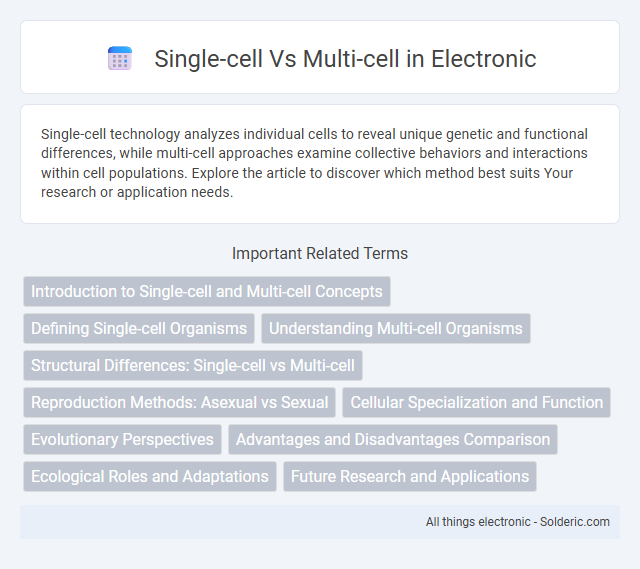Single-cell technology analyzes individual cells to reveal unique genetic and functional differences, while multi-cell approaches examine collective behaviors and interactions within cell populations. Explore the article to discover which method best suits Your research or application needs.
Comparison Table
| Feature | Single-cell | Multi-cell |
|---|---|---|
| Definition | One independent photovoltaic cell | Multiple photovoltaic cells connected in series or parallel |
| Voltage Output | Low voltage (typically ~0.5V per cell) | Higher voltage by combining cells (sum of individual voltages) |
| Current Output | Current depends on single cell's surface area | Current capacity enhanced by parallel connection of cells |
| Applications | Small devices, sensors | Solar panels, larger power systems |
| Complexity | Simple design and manufacturing | Complex design with connectors and interconnections |
| Cost | Lower initial cost | Higher cost due to more components and assembly |
| Efficiency | Limited by single cell capacity | Improved efficiency due to combined output |
Introduction to Single-cell and Multi-cell Concepts
Single-cell and multi-cell technologies are crucial in biological research, with single-cell focusing on analyzing individual cells to understand cellular diversity and function. Multi-cell approaches study interactions between multiple cells, revealing tissue-level dynamics and complex biological processes. Your choice between these methods depends on the specific research goals, such as identifying cell heterogeneity or investigating cell-to-cell communication.
Defining Single-cell Organisms
Single-cell organisms, also known as unicellular organisms, consist of a single cell that performs all the necessary functions of life, including metabolism, reproduction, and response to the environment. These organisms include bacteria, archaea, and many protists, representing the simplest form of life on Earth. Unlike multi-cellular organisms, which rely on specialized cells for different functions, single-cell organisms maintain cellular autonomy and versatility within one cell.
Understanding Multi-cell Organisms
Multi-cell organisms consist of numerous specialized cells working collaboratively to perform complex biological functions, unlike single-cell organisms that operate independently. Cellular differentiation and intercellular communication enable multi-cellular organisms to maintain homeostasis and adapt to environmental changes. Your understanding of these processes highlights the intricate organization vital for growth, development, and survival in multi-cell life forms.
Structural Differences: Single-cell vs Multi-cell
Single-cell systems consist of one independent photovoltaic cell that directly converts sunlight into electricity, featuring a simple structure with a single p-n junction. Multi-cell systems incorporate multiple interconnected cells, often arranged in series or parallel, enhancing voltage or current output and improving efficiency through layer stacking or segment division. Structural differences impact overall performance, with multi-cell configurations enabling higher energy conversion rates and greater reliability compared to single-cell designs.
Reproduction Methods: Asexual vs Sexual
Single-cell organisms primarily reproduce asexually through methods like binary fission, budding, or spore formation, enabling rapid population growth without genetic variation. Multi-cell organisms reproduce sexually by combining genetic material from two parents via gametes, promoting genetic diversity and adaptability. Some multi-cell species also utilize asexual reproduction methods such as fragmentation or vegetative propagation for faster reproduction under specific conditions.
Cellular Specialization and Function
Single-cell organisms perform all essential life functions within a single cell, relying on intracellular mechanisms for survival and reproduction. Multi-cellular organisms exhibit cellular specialization, where different cell types perform distinct functions, such as muscle cells for movement and nerve cells for signal transmission. This division of labor enhances functional efficiency and supports complex biological processes in multi-cellular life forms.
Evolutionary Perspectives
Single-cell organisms represent the earliest form of life, showcasing simplicity and adaptability in diverse environments, while multi-cellular life evolved to achieve specialization and complex biological functions. Genetic innovations such as cell differentiation and intercellular communication mechanisms emerged, facilitating the transition from unicellular to multicellular entities. This evolutionary shift enabled the development of diverse species with higher structural complexity and enhanced survival strategies.
Advantages and Disadvantages Comparison
Single-cell systems excel in simplicity, lower cost, and easy maintenance, making them ideal for small-scale applications or users with limited space. Multi-cell configurations offer higher capacity, improved efficiency, and redundancy, ensuring consistent performance in larger or critical power requirements but come with increased complexity and higher initial investment. Your choice depends on balancing these trade-offs against your power needs and budget constraints.
Ecological Roles and Adaptations
Single-cell organisms play crucial ecological roles as primary producers, decomposers, and symbionts, thriving in diverse environments through rapid reproduction and metabolic versatility. Multi-cell organisms exhibit specialized tissues and complex adaptations that enable them to occupy higher trophic levels and engage in intricate ecological interactions such as predation, competition, and mutualism. Your understanding of these differences reveals how cellular complexity drives ecological diversity and ecosystem stability.
Future Research and Applications
Future research will explore single-cell technologies for precise diagnostics, enabling personalized medicine by analyzing individual cell heterogeneity. Multi-cell approaches remain essential for studying cell-to-cell interactions in complex tissues, advancing tissue engineering and regenerative medicine. Integration of single-cell and multi-cell data promises breakthroughs in understanding disease mechanisms and developing targeted therapies.
Single-cell vs Multi-cell Infographic

 solderic.com
solderic.com